Heroes of the Air: Major L.G. Hawker
WHEN Flying, the new 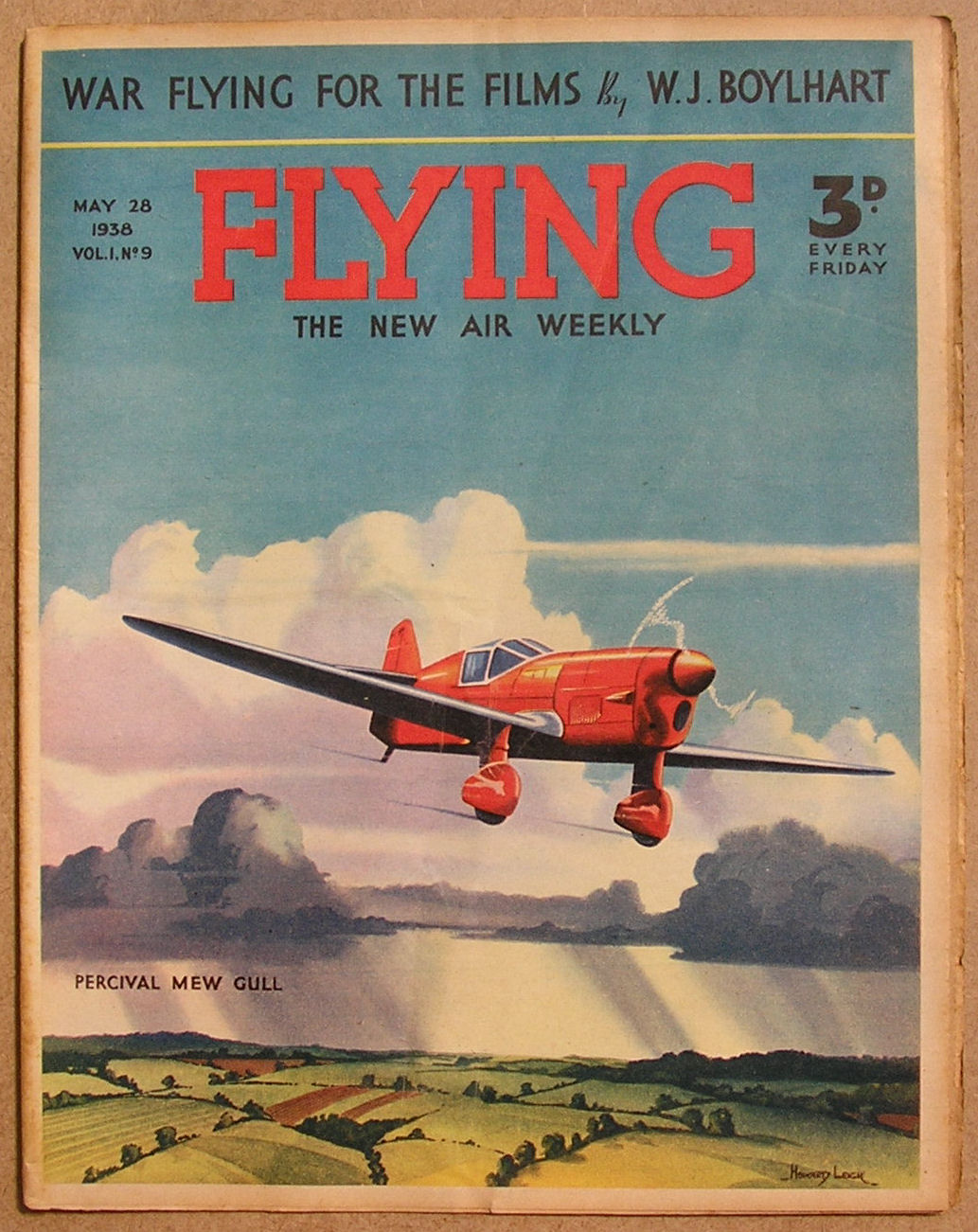 weekly paper of all things aviation, started up in England in 1938, amongst the articles and stories and photo features was an illustrative feature called “Heroes of the Air.” It was a full page illustration by S. Drigin of the events surrounding how the pictured Ace got their Victoria Cross along with a brief explanatory note.
weekly paper of all things aviation, started up in England in 1938, amongst the articles and stories and photo features was an illustrative feature called “Heroes of the Air.” It was a full page illustration by S. Drigin of the events surrounding how the pictured Ace got their Victoria Cross along with a brief explanatory note.
Russian born Serge Drigin became a successful illustrator in the UK in the 1920s with his work regularly appearing in such British magazines as The Detective Magazine, Modern Boy and Chums. He is probably best known for his startling covers for Scoops, Air Stories, War Stories, Fantasy and others in the 30s.
From the 28 May 1938 issue of Flying:
MAJOR L. G. HAWKER WINNING THE VICTORIA CROSS OVER THE GERMAN LINES, JULY 25, 1915
IT WAS on July 25, 1915, that Major Lanoe George Hawker was on reconnaissance over enemy territory. He was flying a Bristol Scout when he saw a German two-seater. He at once engaged it with such fury that it turned tail and fled. Continuing on his way, he encountered another two-seater. This time he was more lucky, for he sent his opponent down out of control. His third victory that day over yet another two-seater, was gained on the way home. It was almost dark at the time and the German machine must have presented a grim picture as it spun down in flames. These three successes were all the more surprising because Major Hawker, at that time a Captain, was armed only with a French cavalry carbine, while his opponents were armed with machine-guns. For his gallantry on that day he was awarded the Victoria Cross. Notification was made on the 24th of August in the London Gazette, for “ most conspicuous bravery and very great ability on the 25th July, 1915.†This fearless airman finally fell to the guns of Richthofen, but only after a long and bitter engagement which in the end was decided by the German’s superior equipment—as Richthofen himself admitted.

Heroes of the Air: Major J.B. McCudden
WHEN Flying, the new 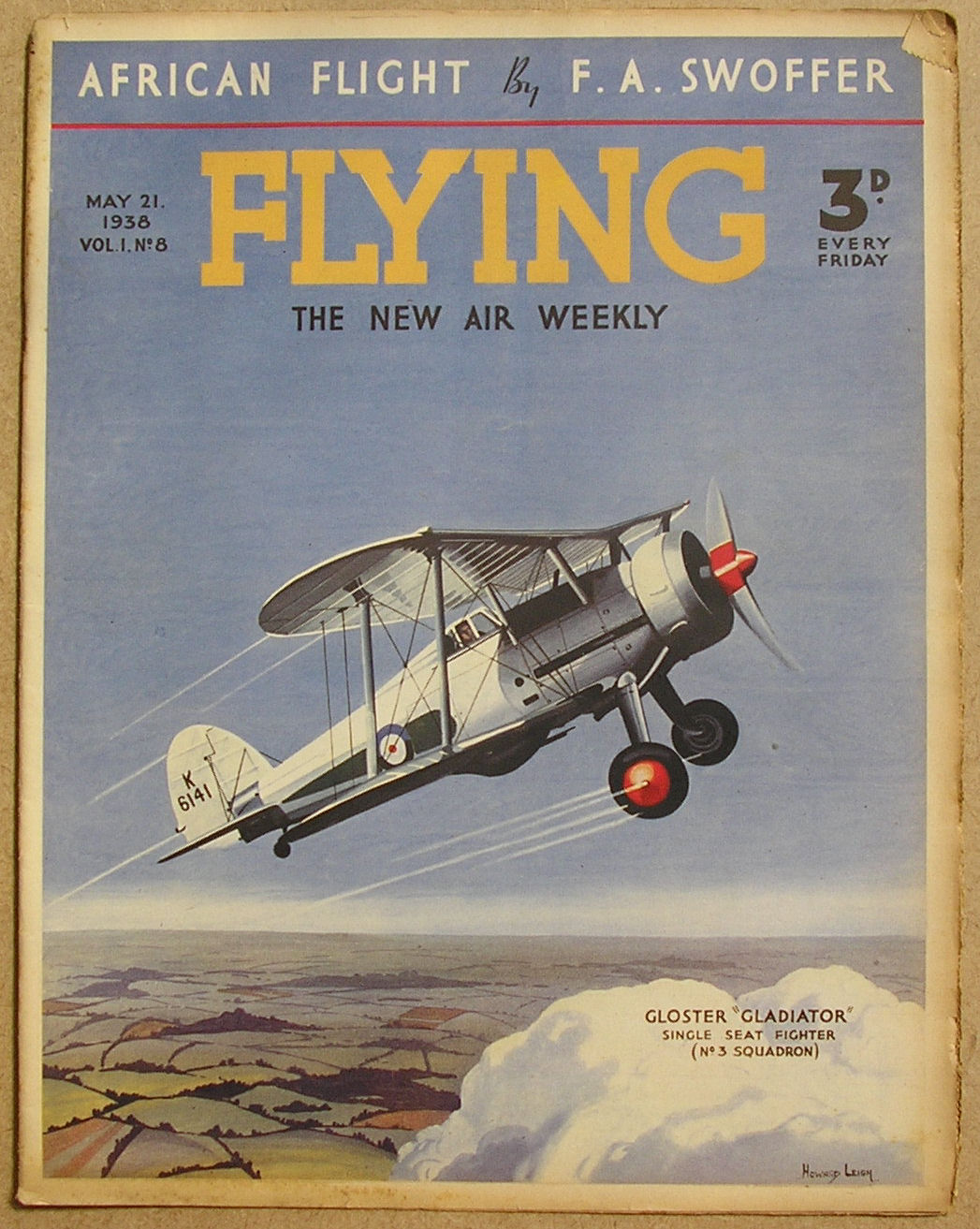 weekly paper of all things aviation, started up in England in 1938, amongst the articles and stories and photo features was an illustrative feature called “Heroes of the Air.” It was a full page illustration by S. Drigin of the events surrounding how the pictured Ace got their Victoria Cross along with a brief explanatory note.
weekly paper of all things aviation, started up in England in 1938, amongst the articles and stories and photo features was an illustrative feature called “Heroes of the Air.” It was a full page illustration by S. Drigin of the events surrounding how the pictured Ace got their Victoria Cross along with a brief explanatory note.
Russian born Serge Drigin became a successful illustrator in the UK in the 1920s with his work regularly appearing in such British magazines as The Detective Magazine, Modern Boy and Chums. He is probably best known for his startling covers for Scoops, Air Stories, War Stories, Fantasy and others in the 30s.
From the 21 May 1938 issue of Flying:
MAJOR J. B. McCUDDEN ATTACKING A HANNOVERANA, FEBRUARY, 1918
THE NOTIFICATIONS of Major J. B. McCudden’s award was made in the following words: “For conspicuous bravery, exceptional perseverance, and a very high devotion to duty. Captain McCudden has at the present time accounted for fifty-four enemy aeroplanes.” McCudden, like several others, was awarded the Victoria Cross not for one particularly brave action, but for consistent gallantry. The incident shown below occurred in February, 1918. It shows his fifty-seventh, and last, victory. McCudden attacked a Hannoverana at close range and poured a stream of bullets into its tail. So furious was this attack that the German observer fell through the shattered fuselage of his machine, to come to earth behind the British lines, while his pilot went on and crashed in German territory. Major McCudden was awarded several other decorations and had the distinction of being the only man to witness the death of Wernher Voss, who was shot down by the guns of Lieutenant Rhys Davids, a member of McCudden’s flight. In July, 1918, he crashed on leaving a French aerodromes for his squadron, and was killed instantaneously. Thus ended the career of one of our most efficient air fighters.

Heroes of the Air: G.S.M. Insall by S. Drigin
WHEN Flying, the new 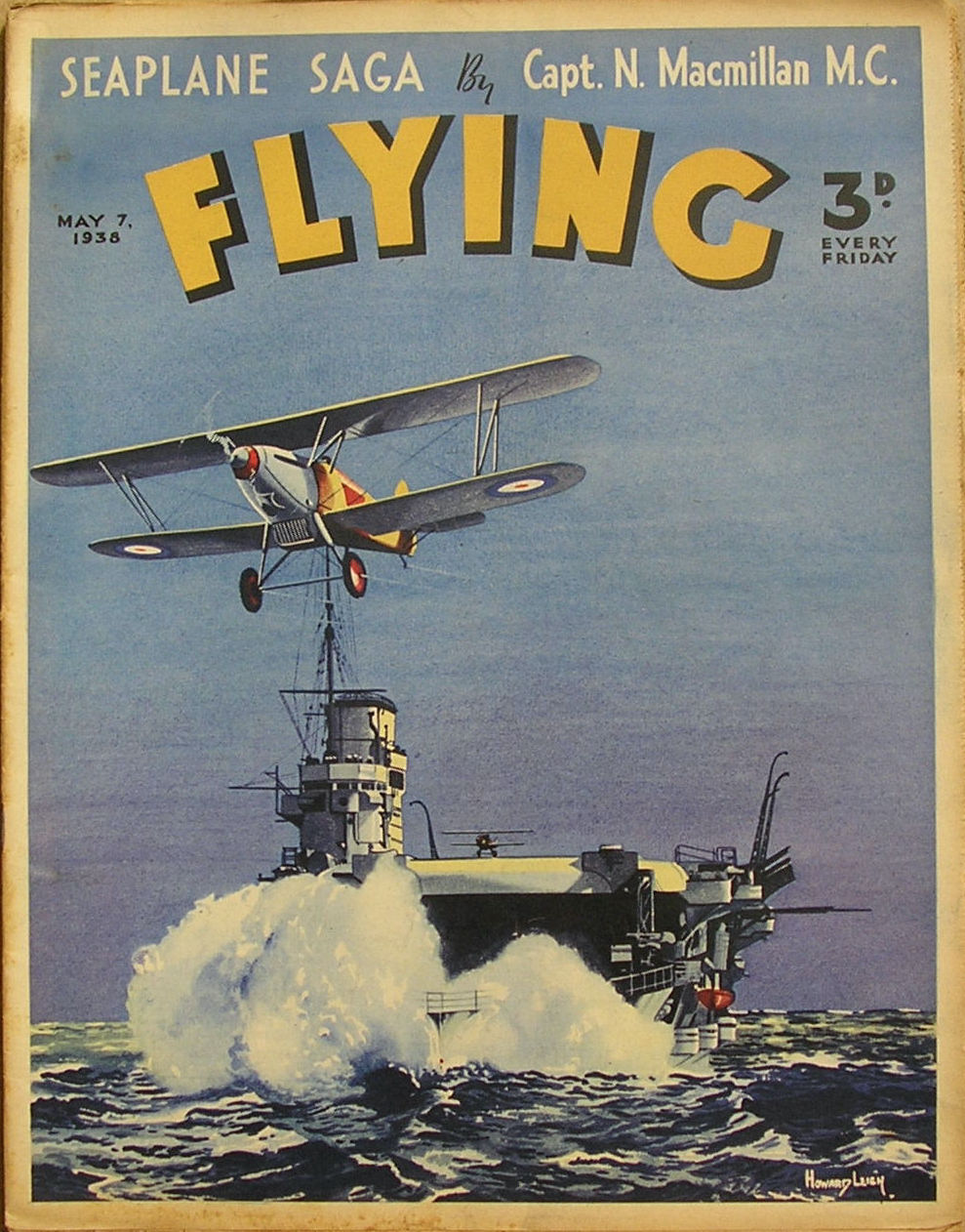 weekly paper of all things aviation, started up in England in 1938, amongst the articles and stories and photo features was an illustrative feature called “Heroes of the Air.” It was a full page illustration by S. Drigin of the events surrounding how the pictured Ace got their Victoria Cross along with a brief explanatory note.
weekly paper of all things aviation, started up in England in 1938, amongst the articles and stories and photo features was an illustrative feature called “Heroes of the Air.” It was a full page illustration by S. Drigin of the events surrounding how the pictured Ace got their Victoria Cross along with a brief explanatory note.
Russian born Serge Drigin became a successful illustrator in the UK in the 1920s with his work regularly appearing in such British magazines as The Detective Magazine, Modern Boy and Chums. He is probably best known for his startling covers for Scoops, Air Stories, War Stories, Fantasy and others in the 30s.
From the 7 May 1938 issue of Flying:
LIEUT. G. S. M. INSALL WINNING THE V.C. IN FRANCE, NOVEMBER 7, 1915
LIEUTENANT Insall was flying a Vickers “Gun Bus†with A.M. T.H. Donald as his gunner on the occasion of the action which won him the V.C. He was on patrol when he saw and pursued an enemy machine. Insall gave his gunner several chances to fire and their adversary was brought down. Not content with this, Insall returned and dropped an incendiary bomb on the German aeroplane to ensure its destruction. Making for home, Insall was forced to land only five hundred yards behind the British lines, whereupon the German artillery opened fire, intent upon completely demolishing the “Gun Bus.†The two flyers took refuge in a shell hole until nightfall, when they crept out to examine their machine. A new petrol tank was needed. They sent for one and fitted it. Other minor repairs were carried out and a digging party was requisitioned from the trenches to level out a runway for a take-off. As dawn came the Vickers rumbled off and winged its way into the air, before the enemy artillery had time to fire a shot. The award of the Victoria Cross was later conferred on Insall for “most conspicuous bravery, skill and determination.â€

Heroes of the Air: Lieut W.A. Bishop
WHEN Flying, the new 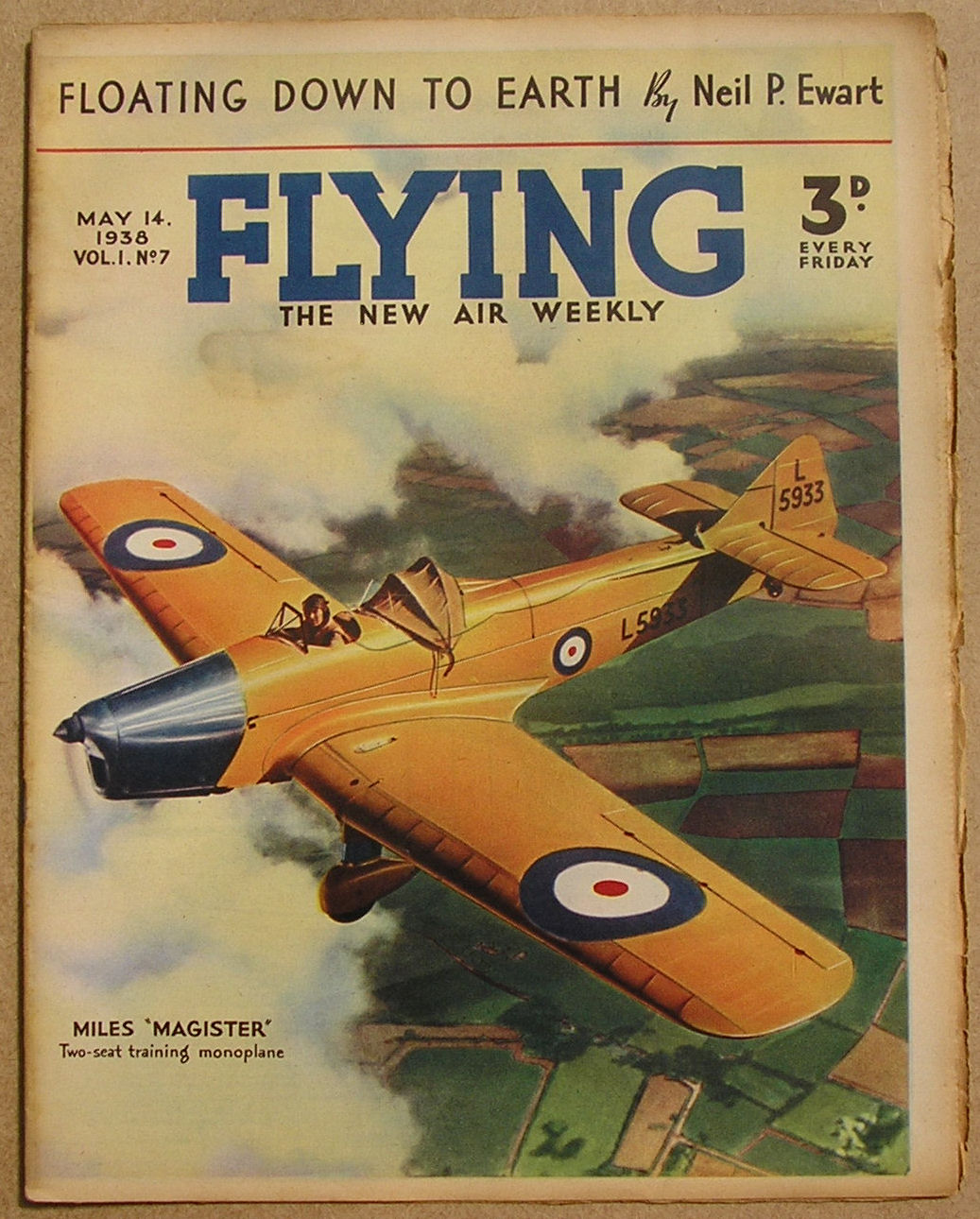 weekly paper of all things aviation, started up in England in 1938, amongst the articles and stories and photo features was an illustrative feature called “Heroes of the Air.” It was a full page illustration by S. Drigin of the events surrounding how the pictured Ace got their Victoria Cross along with a brief explanatory note.
weekly paper of all things aviation, started up in England in 1938, amongst the articles and stories and photo features was an illustrative feature called “Heroes of the Air.” It was a full page illustration by S. Drigin of the events surrounding how the pictured Ace got their Victoria Cross along with a brief explanatory note.
Russian born Serge Drigin became a successful illustrator in the UK in the 1920s with his work regularly appearing in such British magazines as The Detective Magazine, Modern Boy and Chums. He is probably best known for his startling covers for Scoops, Air Stories, War Stories, Fantasy and others in the 30s.
From the 14 May 1938 issue of Flying:
LIEUT. W. A. BISHOP IN COMBAT WITH FIVE GERMAN SCOUTS
THE PICTURE below depicts a spectacular incident in the career of Capt. William Avery Bishop, V.C., which took place the day before he was due to go home on leave. He was on patrol when he was suddenly attacked by five Pfaltz D.12, three-gun scouts. Fifteen guns against two! But Bishop was fearless. Within a few minutes he had sent four of the enemy planes hurtling to the ground in flames. On his way home he tried his hand at a little ground-straffing and later engaged and defeated a two-seater. The event for which he was awarded the Victoria Cross was equally thrilling, although carefully planned. It was June, 1917. Bishop, in the early morning, flew over to a German aerodrome and roused the pilots with the roar of his engine. As he had hoped, the German airmen dashed out to their machines to give combat. As the first took off. Bishop was on his tail and shot him down. The second received the same treatment. Several machines now took off together. Bishop waited to dispose of only one more and then set off for home and breakfast. Notification of his award appeared in the London Gazette of August 11th, 1917.

“Kraut Fishing” by Joe Archibald
“HAW-W-W-W-W!†That sound can only mean 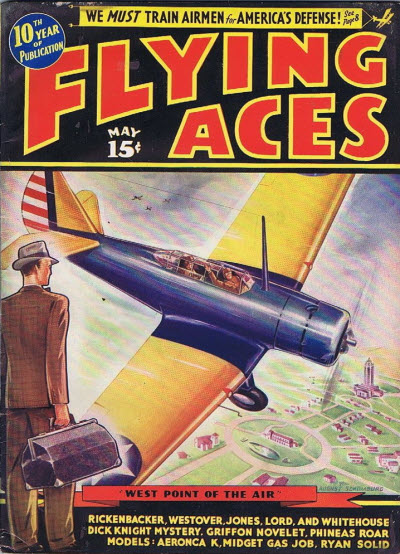 one thing—that Bachelor of Artifice, Knight of Calamity and an alumnus of Doctor Merlin’s Camelot College for Conjurors is back to vex not only the Germans, but the Americans—the Ninth Pursuit Squadron in particular—as well. Yes it’s the marvel from Boonetown, Iowa himself—Lieutenant Phineas Pinkham!
one thing—that Bachelor of Artifice, Knight of Calamity and an alumnus of Doctor Merlin’s Camelot College for Conjurors is back to vex not only the Germans, but the Americans—the Ninth Pursuit Squadron in particular—as well. Yes it’s the marvel from Boonetown, Iowa himself—Lieutenant Phineas Pinkham!
Not long after Lieutenant Phineas “Carbuncle†Pinkham had knocked off Herr Hauptmann Adolph August von Heinz—the Owl of the Ozone, whose nocturnal marauding had been driving the Chaumont brain trust to drunkards’ graves—the Allies had a meeting. And the motion was moved and seconded that a medal be struck off for the hero from Boonetown, Iowa. But two hours after the order was okayed by the Democratic board of directors, Major Rufus Garrity, boss of the turbulent Ninth Pursuit Squadron, wished that Phineas had let the Heinie alone. For irked no end by the news that von Heinz had been shellacked for a row of ammo dumps by Lieutenant Pinkham, a certain Boche bombing outfit hopped into their egg crates close to dawn of the day following the descendu of their Kraut hero who doted on darkness. In the confusion of the subsequent bombing of the Ninth by the von Schmierwurst’s gory Grim Reapers, The Owl flew the coup hiding in the woods full of his nocturnal friends!
Neither of the international shooting parties encamped in that noxious neighborhood bordering Bar-le-Duc was in a sugary mood. To the Teuton tracer-tossers, the capture of their sinister Spandau-ist, Hauptmann von Heinz, had proved a decided pain-in-the-neck. Likewise, von Schmierwurst’s gory Grim Reapers had become a pain-in-the-neck to the Democrats. And Phineas? You guessed it! He was a pain-in-the-neck to everybody!
Richard Knight in “Vultures of Silence” by Donald E. Keyhoe
THE unstoppable Donald E. Keyhoe  had a story in a majority of the issue of Flying Aces from his first in January 1930 until he returned to the Navy in 1942. Starting in August 1931, they were stories featuring the weird World War I stories of Philip Strange. But in November 1936, he began alternating these with sometime equally weird present day tales of espionage Ace Richard Knight—code name Agent Q. After an accident in the Great War, Knight developed the uncanny ability to see in the dark. Aided by his skirt-chasing partner Larry Doyle, Knights adventures ranged from your basic between the wars espionage to lost valley civilizations and dinosaurs. Secret agents from a dozen countries have all rushed into the Mediterranean for something—but what? Knight and Doyle set out to find out just what it could be. The carrier from which they’ve just taken off mysteriously and soundlessly explodes leaving nothing behind! Just what is out there?
had a story in a majority of the issue of Flying Aces from his first in January 1930 until he returned to the Navy in 1942. Starting in August 1931, they were stories featuring the weird World War I stories of Philip Strange. But in November 1936, he began alternating these with sometime equally weird present day tales of espionage Ace Richard Knight—code name Agent Q. After an accident in the Great War, Knight developed the uncanny ability to see in the dark. Aided by his skirt-chasing partner Larry Doyle, Knights adventures ranged from your basic between the wars espionage to lost valley civilizations and dinosaurs. Secret agents from a dozen countries have all rushed into the Mediterranean for something—but what? Knight and Doyle set out to find out just what it could be. The carrier from which they’ve just taken off mysteriously and soundlessly explodes leaving nothing behind! Just what is out there?
Toward grim Gibraltar, Dick Knight sped his sleek Vought. For Europe’s craftiest spies were hurrying into that caldron of intrigue just beyond “The Rock”—and Washington’s orders had been terse: “Find out why”! But already that sinister sea was red with the blood of rash agents who had ventured too far. And already it was too late for Dick Knight to turn back. For he had defied muted murder—had defied “The Death that had no face”!
“They Had What It Takes – Parts 16 & 17: Capt. Edwin Musick & Sir Hubert Wilkins†by Alden McWilliams
It’s been a while, but we’re back with two of Alden McWilliams’ illustrated tributes to the pioneer fliers of the early days of aviation. McWilliams’ “They Had What it Takes†ran for several years in Flying Aces magazine in the thirties and these installments appeared in 1938. Part 16 appeared in the May issue and featured beloved early commercial aviator Capt. Edwin Musick, famed for piloting PanAm’s China Clipper! Following this in the June issue, McWilliams featured Sir Hubert Wilkins, the famed Australian Arctic Explorer. Here’s some newsreel footage of him and the plane he had just piloted over the North Pole in 1928 and thirty years later signing in on the game show What’s My Line as Mr X in 1958.
 weekly paper of all things aviation, started up in England in 1938, amongst the articles and stories and photo features was an illustrative feature called “Heroes of the Air.” It was a full page illustration by S. Drigin of the events surrounding how the pictured Ace got their Victoria Cross along with a brief explanatory note.
weekly paper of all things aviation, started up in England in 1938, amongst the articles and stories and photo features was an illustrative feature called “Heroes of the Air.” It was a full page illustration by S. Drigin of the events surrounding how the pictured Ace got their Victoria Cross along with a brief explanatory note. 





 weekly paper of all things aviation, started up in England in 1938, amongst the articles and stories and photo features was an illustrative feature called “Heroes of the Air.” It was a full page illustration by S. Drigin of the events surrounding how the pictured Ace got their Victoria Cross along with a brief explanatory note.
weekly paper of all things aviation, started up in England in 1938, amongst the articles and stories and photo features was an illustrative feature called “Heroes of the Air.” It was a full page illustration by S. Drigin of the events surrounding how the pictured Ace got their Victoria Cross along with a brief explanatory note. 
 weekly paper of all things aviation, started up in England in 1938, amongst the articles and stories and photo features was an illustrative feature called “Heroes of the Air.” It was a full page illustration by S. Drigin of the events surrounding how the pictured Ace got their Victoria Cross along with a brief explanatory note.
weekly paper of all things aviation, started up in England in 1938, amongst the articles and stories and photo features was an illustrative feature called “Heroes of the Air.” It was a full page illustration by S. Drigin of the events surrounding how the pictured Ace got their Victoria Cross along with a brief explanatory note. 
 weekly paper of all things aviation, started up in England in 1938, amongst the articles and stories and photo features was an illustrative feature called “Heroes of the Air.” It was a full page illustration by S. Drigin of the events surrounding how the pictured Ace got their Victoria Cross along with a brief explanatory note.
weekly paper of all things aviation, started up in England in 1938, amongst the articles and stories and photo features was an illustrative feature called “Heroes of the Air.” It was a full page illustration by S. Drigin of the events surrounding how the pictured Ace got their Victoria Cross along with a brief explanatory note. 
 one thing—that Bachelor of Artifice, Knight of Calamity and an alumnus of Doctor Merlin’s Camelot College for Conjurors is back to vex not only the Germans, but the Americans—the Ninth Pursuit Squadron in particular—as well. Yes it’s the marvel from Boonetown, Iowa himself—Lieutenant Phineas Pinkham!
one thing—that Bachelor of Artifice, Knight of Calamity and an alumnus of Doctor Merlin’s Camelot College for Conjurors is back to vex not only the Germans, but the Americans—the Ninth Pursuit Squadron in particular—as well. Yes it’s the marvel from Boonetown, Iowa himself—Lieutenant Phineas Pinkham! had a story in a majority of the issue of Flying Aces from his first in January 1930 until he returned to the Navy in 1942. Starting in August 1931, they were stories featuring the weird World War I stories of Philip Strange. But in November 1936, he began alternating these with sometime equally weird present day tales of espionage Ace Richard Knight—code name Agent Q. After an accident in the Great War, Knight developed the uncanny ability to see in the dark. Aided by his skirt-chasing partner Larry Doyle, Knights adventures ranged from your basic between the wars espionage to lost valley civilizations and dinosaurs. Secret agents from a dozen countries have all rushed into the Mediterranean for something—but what? Knight and Doyle set out to find out just what it could be. The carrier from which they’ve just taken off mysteriously and soundlessly explodes leaving nothing behind! Just what is out there?
had a story in a majority of the issue of Flying Aces from his first in January 1930 until he returned to the Navy in 1942. Starting in August 1931, they were stories featuring the weird World War I stories of Philip Strange. But in November 1936, he began alternating these with sometime equally weird present day tales of espionage Ace Richard Knight—code name Agent Q. After an accident in the Great War, Knight developed the uncanny ability to see in the dark. Aided by his skirt-chasing partner Larry Doyle, Knights adventures ranged from your basic between the wars espionage to lost valley civilizations and dinosaurs. Secret agents from a dozen countries have all rushed into the Mediterranean for something—but what? Knight and Doyle set out to find out just what it could be. The carrier from which they’ve just taken off mysteriously and soundlessly explodes leaving nothing behind! Just what is out there?